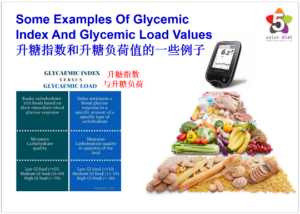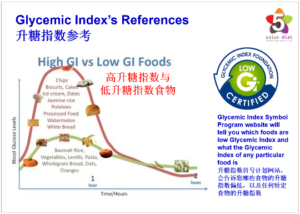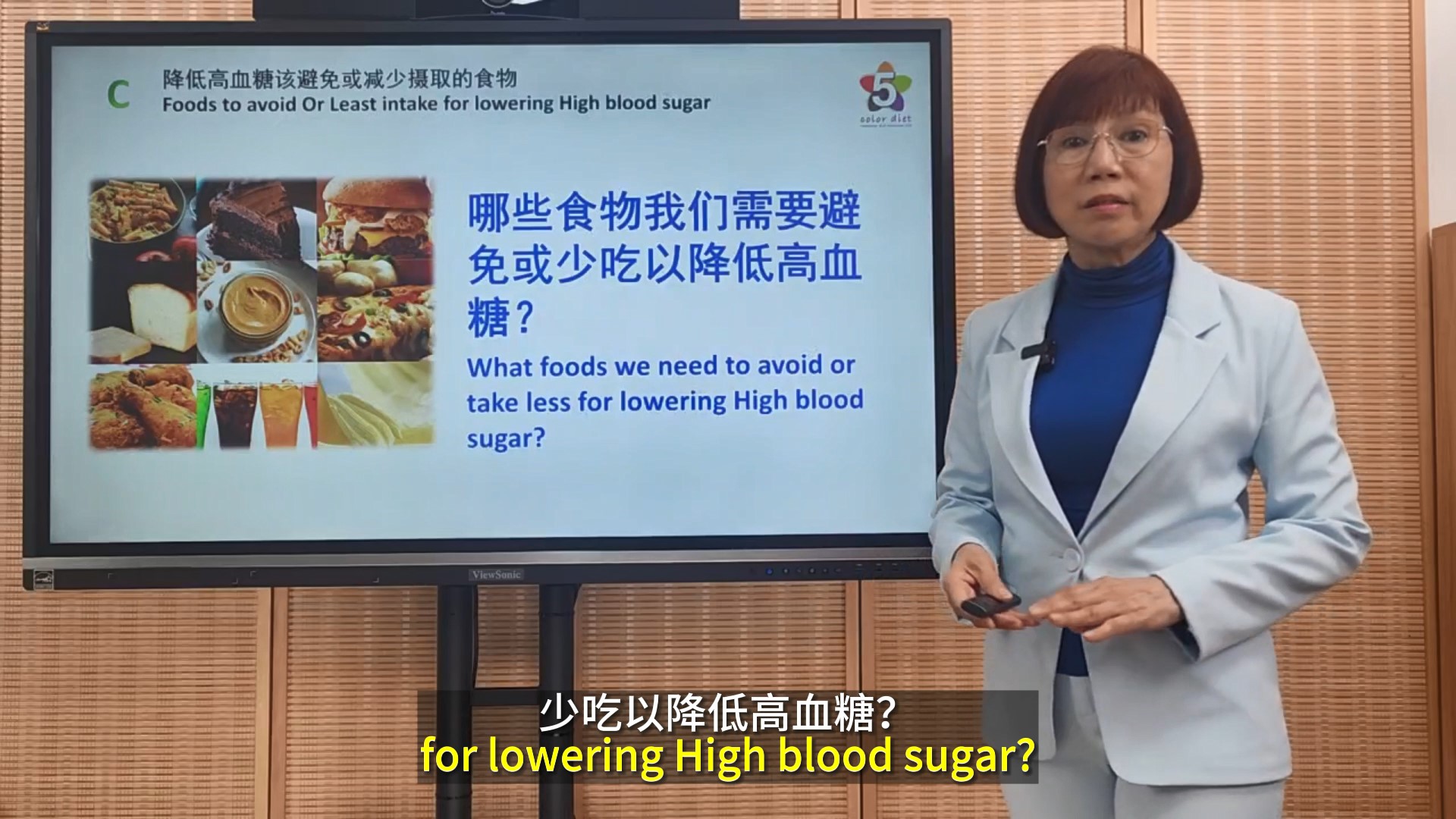
Originally, nutritionists believed that starchy carbohydrates like bread and potatoes were “Complex” and because of this took longer to be digested and absorbed than “Simple” sugars like sugar. It was reasoned that these “Complex” carbohydrates would then produce smaller rises in blood sugar levels than “Simple” carbohydrates, which were thought to cause a surge of blood sugar. That’s why, at that time, sugar was banned from diabetic diets and sugar-free recipes for desserts, cakes and biscuits became a necessary part of diabetes therapy (even though they may have been high in fat).
However, researchers from Canada, Australia and the United Kingdom has turned this notion on its head and has shown that many starchy foods like white bread, potato and many types of rice are digested and absorbed very quickly (and therefore have a high Glycemic Index ranking). It also showed that sugar has only a moderate effect on blood sugar, often lower in fact than bread or rice or refined starches.
The Glycemic Index was invented in 1981 by Dr Thomas Wolever and Dr David Jenkins at the University of Toronto and is a measure of how quickly a food containing 25 or 50 grams of carbohydrate raises blood-glucose levels. Because some foods typically have a low carbohydrate content, Harvard researchers created the Glycemic Load, which takes into account the amount of carbohydrates in a given serving of a food and so provides a more useful measure. Liu et al. were the first to show that based on their calculation, the Glycemic Load of a specific food which calculated as the product of that food’s carbohydrate content and its Glycemic Index value which has direct physiologic meaning in that each unit can be interpreted as the equivalent of 1 gram carbohydrate from white bread (or glucose depending on the reference used in determining the Glycemic Index). It became immediately apparent that such direct physiological quantification of Glycemic Load would allow patients with diabetes to do “Glycemic Load” counting as opposed to the conventional “carbohydrate counting” for monitoring the glycemic effect of foods. The concept of Glycemic Load addresses the concern about rating foods as good or bad solely on the basis of their Glycemic Index. Reliable tables of Glycemic Index (GI) compiled from the scientific literature are instrumental in improving the quality of research examining the relation between Glycemic Index, Glycemic Load and health.
The Glycemic Index indicates how rapidly a carbohydrate is digested and released as glucose (sugar) into the blood stream. In other words, how quickly foods break down into sugar in your bloodstream. A food with a high Glycemic Index raises blood sugar more than a food with a medium to low Glycemic Index. But the Glycemic Index does not take into account the amount of carbohydrate in a food. So Glycemic Load is a better indicator of how carbohydrate foods will affect the blood sugar.
Food ranked high on the Glycemic Index may represent a huge portion of a food because Glycemic Index is not based on standard serving sizes. Basically, if a food is ranked high on the Glycemic Index, it has readily available carbohydrate for quick absorption. However, the same food can have a low Glycemic Load because there may not actually be much total carbohydrate in a given serving of that food. A low Glycemic Load is the better indicator that a food won’t have much impact on blood glucose levels.
There are no Glycemic Index values given for meat, poultry, fish, avocados, salad vegetables, cheese, or eggs because these foods contain little or no carbohydrate and it would be exceedingly difficult for people to consume a portion of the foods containing 50 grams or even 25 grams of available carbohydrate. Even in large amounts, these foods when eaten alone are not likely to induce a significant rise in blood glucose.
What is Glycemic Load?
The effect of a carbohydrate food on blood sugar levels is not only determined by its Glycemic Index or carbohydrate quality but also by the amount of carbohydrate in a particular food. Glycemic Load is the term used to describe the overall effect of these two factors, Glycemic Index and Glycemic Load on blood sugar and measures the amount of carbohydrates in a serving of food as follows:
(1) Foods with a Glycemic Load (GL) under 10 are considered low-Glycemic Load foods and have little impact on your blood sugar.
(2) Between 10 and 20 moderate-Glycemic Load (GL) foods with moderate impact on blood sugar.
(3) Above 20 high-Glycemic Load (GL) foods that tend to cause blood sugar spikes.
Example 1
The Glycemic Load of a potato (Glycemic Index around 90) containing approximately 18 grams of carbohydrate is 18 x 90% = 16.
The Glycemic Load of an apple (Glycemic Index around 40) containing approximately 15 grams of carbohydrate is 15 x 40% = 6.
From this we can see the potato will produce a blood sugar rise three times that of the apple. When foods have similar amounts of carbohydrate, Glycemic Index will have the greatest influence on blood sugars. When the amount of carbohydrate in a portion differs the best way to predict blood sugar effects will be via the Glycemic Load.
Example 2
The Glycemic Index of watermelon is high (Glycemic Index = 72), but its Glycemic Load is relatively low (Glycemic Load = 7), because the quantity of carbohydrate in a slice of watermelon (150 g) is minimal, as it contains a lot of water.
Glycemic Load and Glycemic Index are similar concepts, except that Glycemic Load takes serving sizes into account. It is calculated by taking the number of grams of carbohydrate in a serving, multiplying by the Glycemic Index, and dividing by 100.2
It is best not to try to keep your blood sugar levels down limiting the total amount of carbohydrate you consume. This can lead to a diet that is higher in fat and often higher in kilojoules, which can cause weight gain.
Everyone can benefit by eating a balanced diet of protein and fat, and foods that are lower on the Glycemic Load and Glycemic Index index. Foods with a lower Glycemic Load and Glycemic Index typically are high in fiber and nutrients and sustain your energy better throughout the day. Also, knowing the Glycemic Load of a food is a better indicator of whether that food will cause your blood sugar to spike. When your blood sugar spikes, the body releases extra insulin to bring down your blood sugar. If your body is asked to release extra insulin on a regular basis, it begins to lead to insulin resistance for many people and diabetes, especially if diabetes is in your family.
Consuming low Glycemic Load and Glycemic Index foods keeps us satiated longer because these foods are more slowly broken down for glucose utilization. The result is that you feel fuller for longer. When you consume high Glycemic Load and Glycemic Index foods, blood sugar levels spike which causes a short-term feeling of fullness, but then blood sugars plummet which causes you to crave food again and you ultimately end up consuming excess calories, which contributes to weight gain.
Both the amount and type of carbohydrate you eat affects your after-meal blood glucose levels. The American Diabetes Association’s “Standards of Medical Care in Diabetes 2014” note that monitoring carbohydrate intake “remains a key strategy in achieving glycemic control.” They additionally note that “reductions in A1C of -0.2% to -0.5% have been demonstrated in some studies” looking at the use of Glycemic Index and Glycemic Load in people with diabetes.
Choosing more carbohydrate foods with a medium or low Glycemic Index in place of foods with a high Glycemic Index is one way to lower the overall Glycemic Load of your meal plan. Another way is to consume less carbohydrate overall. A general rule of thumb for remembering which carbohydrate-containing foods have a lower Glycemic Index is the less processed a food is, the lower its Glycemic Index is likely to be.
Lowering your Glycemic Load has been shown to make a difference in blood glucose levels, weight control, and prevention of heart diseases.
-
Some Examples Of Glycemic Index And Glycemic Load Values
Food Group Food Glycemic Index Serving Size Glycemic Load Per Serving Vegetables Spinach 0 30g (1 cup) 0.0 Mushrooms 0 70g (1 cup) 0.0 Green Beans 0 135g (1 cup) 0.0 Cauliflower 0 100g (1 cup) 0.0 Celery, raw 0 62g (1 stalk) 0.0 Cabbage, cooked 0 75g (1/2 cup) 0.0 Broccoli, cooked 0 78g (1/2 cup) 0.0 Tomato 38 123g (medium) 1.5 Frozen Peas 48 72g (1/2 cup) 3.4 Yams 51 136g (1 cup) 16.8 Sweet Potatoes 54 133g (1 cup) 12.4 Yellow Corn 55 166g (1 cup) 61.5 Potato 104 213g (medium) 36.4 Potato, baked 111 150g 33.0 Potato, boiled 82 150g 21.0 Parsnips 97 78g (1/2 cup) 11.6 Beets, canned 64 246g (1/2 cup) 9.6 Fruits Sweet Cherries, raw 22 117g (1 cup) 3.7 Plum 24 66g (1 fruit) 1.7 Grapefruit 25 123g (1/2 fruit) 2.8 Peach 28 98g (medium) 2.2 Prunes 29 132g (1 cup) 34.2 Dried Apricots 32 130g (1 cup) 23.0 Pear 33 166g (medium) 6.9 Apple, with skin 39 138g (medium) 6.2 Strawberries 40 152g (1 cup) 3.6 Grapes 43 92g (1 cup) 6.5 Pears, canned 44 248g (1 cup) 12.3 Orange 48 140g (1 fruit) 7.2 Banana 51 118g (medium) 12.2 Mangos 51 165g (1 cup) 12.8 Peaches, canned 52 251g (1 cup) 17.7 Fruit Cocktail 55 214g (1 cup) 19.8 Kiwi, with skin 58 76g (1 fruit) 5.2 Papayas 60 140g (1 cup) 6.6 Raisins 64 43g (small box) 20.5 Apricots, canned 64 253g (1 cup) 24.3 Cantaloupe 65 177g (1 cup) 7.8 Pineapple 66 155g (1 cup) 11.9 Watermelon 72 152g (1 cup) 7.2 Legumes Peanuts 13 146g (1 cup) 1.6 Soy Beans 20 172 (1 cup) 1.4 Kidney Beans 27 256g (1 cup) 7.0 Lentils 29 198g (1 cup) 7.0 Chickpeas, boiled 31 240g (1 cup) 11.3 Pinto Beans 39 171g (1 cup) 11.7 Lima Beans 31 241g (1 cup) 7.4 Baked Beans 48 254g (1 cup) 18.2 Nuts Cashews 22 N/A N/A Hazelnuts 0 N/A N/A Almonds 0 N/A N/A Macadamia Nuts 0 N/A N/A Pecans 0 N/A N/A Walnuts 0 N/A N/A Dairy Ice Cream 38 72g (1/2 cup) 6.0 Low-Fat Ice Cream 47 76g (1/2 cup) 9.4 Whole Milk 40 244g (1 cup) 4.4 Plain Yogurt 36 245g (1 cup) 6.1 Beverages Tomato Juice 38 243g (1 cup) 3.4 Apple Juice 41 248g (1 cup) 11.9 Soy Milk 44 245g (1 cup) 4.0 Grapefruit Juice 48 250g (1 cup) 13.4 Orange Juice 57 249g (1 cup) 14.25 Cola 63 370g (12 oz.) 25.2 Hot Chocolate 51 28g (1 packet) 11.7 Cranberry Juice 68 253g (1 cup) 24.5 Gatorade 78 16g (3/4 scoop) 11.7 Candy/Sweets Peanut M&Ms 33 30g (1 ounce) 5.6 Strawberry Jam 51 2 tablespoons 10.1 Jelly Beans 78 1 ounce 22 Honey 87 2 tablespoons 17.9 Snickers Bar 68 60g (1/2 bar) 23.0 Table Sugar 68 2 tablespoons 7.0 Grains Quinoa 53 150g (1 cup) 13.0 White Rice 89 150g (1 cup) 43.0 Brown Rice 50 150g (1 cup) 16.0 Bulgur 48 150g (1 cup) 12.0 Couscous 65 150g (1 cup) 9.0 Pearled Barley 28 150g (1 cup) 12.0 Cereals Oatmeal 55 250g (1 cup) 13.0 Muesli 66 30g (1 cup) 16.0 Bran Cereal 55 30g (1 cup) 12.0 Puffed Wheat 80 30g (1 cup) 17.0 Cheerios 74 30g (1 cup) 13.3 Rice Krispies 82 33g (1.25 cup) 23.0 Baked Goods Graham Cracker 74 14g (1 squares) 8.1 Kaiser Roll 73 57g (1 roll) 21.2 Bagel 72 89g (1/4 in.) 33.0 Glazed donut 76 75g (large) 24.3 White Bread 70 25g (1 slice) 8.4 Wheat Bread 70 28g (1 slice) 7.7 Banana cake (made with sugar) 47 60g 14 Banana cake (made without sugar) 55 60g 12 Sponge cake (plain) 46 63g 17 Pita bread, white 68 30g 10 Corn tortilla 52 50g 12 Wheat tortilla 30 50g 8 Hamburger bun 61 30g 9 Miscellaneous Hummus 6 30g 0.0 Popcorn 55 8g (1 cup) 2.8 Cheese Pizza 80 100g 22.0 -
Some Strategies For Lowering Dietary Glycemic Load
• Increasing the consumption of whole grains, nuts, legumes, fruit, and non-starchy vegetables.
• Decreasing the consumption of starchy, moderate- and high-Glycemic Index foods like potatoes, white rice, and white bread, etc.
• Decreasing the consumption of sugary foods like cookies, cakes, candy, and soft drinks.
• Protein alone does not raise blood glucose, but few if any foods contain only protein. Most foods that are high in protein also contain fat, such as meat, poultry, fish, dairy products, and nuts, and some contain carbohydrate, including dairy products, nuts, and beans. Some foods contain carbohydrates will have a Glycemic Index value, while some foods do not contain carbohydrates.
• Fat alone or in combination with protein does not raise blood glucose, so foods such as butter, margarine, oil, and meat do not have a Glycemic Index value. When fat is combined with carbohydrates, it tends to lower the Glycemic Index value of the food, since fat slows digestion. This is why potato chips have a lower Glycemic Index than boiled white potatoes and this in turn is an illustration of why a food’s Glycemic Index value is not the only thing to consider when deciding what to eat.
• Choosing foods that are lower in saturated fat and higher in monounsaturated and polyunsaturated fatty acids is important for heart health, regardless of Glycemic Index. Examples of healthier fats and fatty foods include olive oil, canola oil, liquid margarine, nuts and avocado, etc.
• Consuming a food along with protein, fat, or other carbohydrates that have a lower Glycemic Index effectively lowers its Glycemic Index value. Other things that can affect a food’s Glycemic Index value include the ripeness of fruits (underripe fruits have a lower Glycemic Index than ripe fruit) and how foods are cooked or otherwise processed.
• In people with diabetes, the Glycemic Index value of a food is additionally affected by a person’s pre-meal blood glucose level. If a person’s blood glucose level is elevated, the Glycemic Index of a food is lower than normal, and if a person’s blood glucose is low, the Glycemic Index of the food goes up.
A small study published in The American Journal of Clinical Nutrition in 2011 found that the Glycemic Load of a portion of a single food or of a meal (with a mix of foods) was a better predictor of after-meal blood glucose level than the carbohydrate content of the food portion or meal.
-
Research Studies Of The Effects Of Low Dietary Glycemic Index & Glycemic Load Foods On Some Health Diseases
A variety of other studies have looked at the effects of following a low-Glycemic Index or low-Glycemic Load diet on diabetes control and on heart disease risk factors, and they have generally shown positive effects.
• Disease Prevention – Type 2 Diabetes Mellitus: The consumption of high-Glycemic Index and –Glycemic Load diets for several years might result in higher postprandial blood glucose concentration and excessive insulin secretion. This might contribute to the loss of insulin-secreting function pancreatic β-cells and lead to irreversible type 2 diabetes mellitus. A United States ecologic study of national data from 1909 to 1997 found that the increased consumption of refined carbohydrates in the form of corn syrup, coupled with the declining intake of dietary fiber, has paralleled the increased prevalence of type 2 diabetes. In addition, high-Glycemic Index and –Glycemic Load diets have been associated with an increased risk of type 2 diabetes in several large prospective cohort studies. A recent updated analysis of three large United States cohorts indicated consumption of foods with the highest versus lowest Glycemic Index was associated with a risk of developing type 2 diabetes that was increased by 44% in the Nurses’ Health Study 1 (NHS), 20% in the Nurses’ Health Study 2 (NHS), and 30% in the Health Professionals Follow-up Study (HPFS). High-Glycemic Load diets were associated with an increased risk of type 2 diabetes (+18%) only in the Nurses’ Health Study 1 and in the pooled analysis of the three studies (+10%) . Additionally, the consumption of high-Glycemic Index foods that are low in cereal fiber was associated with a 59% increase in diabetes risk compared to low-Glycemic Index and high-cereal-fiber foods. High-Glycemic Load and low-cereal-fiber diets were associated with a 47% increase in risk compared to low-Glycemic Load and high-cereal-fiber diets. Moreover, obese participants who consumed foods with high-Glycemic Index or –Glycemic Load values had a risk of developing type 2 diabetes that was more than 10-fold greater than lean subjects consuming low-Glycemic Index or –Glycemic Load diets.
However, a number of prospective cohort studies have reported a lack of association between Glycemic Index or Glycemic Load and type 2 diabetes. The use of Glycemic Index food classification tables based predominantly on Australian and American food products might be a source of Glycemic Index value mis-assignment and partly explain null associations reported in many prospective studies of European and Asian cohorts.
Nevertheless, conclusions from several recent meta-analyses of prospective studies (including the above-mentioned studies) suggest that low-Glycemic Index and –Glycemic Load diets might have a modest but significant effect in the prevention of type 2 diabetes. Organizations like Diabetes UK and the European Association for the Study of Diabetes have included the use of diets of low Glycemic Index/ Glycemic Load and high in dietary fiber and whole grains in their recommendations for diabetes prevention in high-risk individuals. The use of Glycemic Index and Glycemic Load is currently not implemented in United States dietary guidelines.
• Disease Treatment – Diabetes mellitus: Whether low-Glycemic Index foods could improve overall blood glucose control in people with type 1 or type 2 diabetes mellitus has been investigated in a number of intervention studies. A meta-analysis of 19 randomized controlled trials that included 840 diabetic patients (191 with type 1 diabetes and 649 with type 2 diabetes) found that consumption of low-Glycemic Index foods improved short-term and long-term control of blood glucose concentrations, reflected by significant decreases in fructosamine and glycated hemoglobin (HbA1c) levels. However, these results need to be cautiously interpreted because of significant heterogeneity among the included studies. The American Diabetes Association has rated poorly the current evidence supporting the substitution of low-Glycemic Load foods for high-Glycemic Load foods to improve Glycemic control in adults with type 1 or type 2 diabetes. Well-controlled studies are needed to further assess whether the use of low-Glycemic Index/ Glycemic Load diets could significantly improve long-term Glycemic control and the quality of life of subjects with diabetes.
A randomized controlled study in 92 pregnant women (20-32 weeks) diagnosed with gestational diabetes found no significant effects of a low-Glycemic Index diet on maternal metabolic profile (e.g., blood concentrations of glucose, insulin, fructosamine, HbA1c; insulin resistance) and pregnancy outcomes (i.e., maternal weight gain and neonatal anthropometric measures) compared to a conventional high-fiber, moderate-Glycemic Index diet. The low-Glycemic Index diet consumed during the pregnancy also failed to improve maternal glucose tolerance, insulin sensitivity, and other cardiovascular risk factors, or maternal and infant anthropometric data in a three-month postpartum follow-up study of 55 of the mother-infant pairs. In addition, another trial in 139 pregnant women (12-20 weeks’ gestation) at high risk for gestational diabetes showed no statistical differences regarding the diagnosis of gestational diabetes during the second and third trimester of pregnancy, the requirement for insulin therapy, and pregnancy outcomes and neonatal anthropometry whether women followed a low-Glycemic Index diet or a high-fiber, moderate-Glycemic Index diet. At present, there is no evidence that a low-Glycemic Index diet provides benefits beyond those of a healthy, moderate-Glycemic Index diet in women at high risk or affected by gestational diabetes.
• Cardiovascular Diseases (Observational Studies): Numerous observational studies have examined the relationship between dietary Glycemic Index/ Glycemic Load and the incidence of cardiovascular events, especially Coronary Heart Disease (CHD) and stroke. A meta-analysis of 14 prospective cohort studies (229,213 participants; mean follow-up of 11.5 years) found a 13% and 23% increased risk of Cardiovascular Disease (CVD) with high versus low dietary Glycemic Index and Glycemic Load, respectively. Three independent meta-analyses of prospective studies also reported that higher Glycemic Index or Glycemic Load was associated with increased risk of Coronary Heart Disease in women but not in men. A recent analysis of the European Prospective Investigation (EPIC) into Cancer and Nutrition study in 20,275 Greek participants, followed for a median of 10.4 years, showed a significant increase in Coronary Heart Disease incidence and mortality with high dietary Glycemic Load specifically in those with high Body Mass Index (BMI) (≥28 kg/m2). This is in line with earlier findings in the Nurses’ Health Study (NHS) showing that a high dietary Glycemic Load was associated with a doubling of the risk of Coronary Heart Diesase over 10 years in women with higher (≥23 kg/m2) versus lower Body Mass Index (BMI). A similar finding was reported in a cohort of middle-aged Dutch women followed for nine years.
Additionally, high dietary Glycemic Load (but not Glycemic Index) was associated with a 19% increased risk of stroke in pooled analyses of prospective cohort studies. A meta-analysis of seven prospective studies (242,132 participants; 3,255 stroke cases) found that high dietary Glycemic Load was associated with an overall 23% increase in risk of stroke and a specific 35% increase in risk of ischemic stroke but was not found to be related to hemorrhagic stroke. Overall, observational studies have found that higher Glycemic Load diets are associated with increased risk of cardiovascular disease, especially in women and in those with higher Body Mass Indexs (BMIs).
• Heart disease: People who follow diets with a high Glycemic LOad tend to have increased triglyceride levels and lowered High-Density Lipoprotein (HDL) cholesterol levels, both of which raise the risk of heart disease. In a large study involving 750,000 female nurses, over a 10-year period, the women who followed the diets with the highest Glycemic Load were almost twice as likely to develop coronary heart disease as those following a diet with a lower Glycemic Load. Among the women who followed a high-Glycemic Load diet are overweight and obese women who were more likely to develop coronary heart disease than normal-weight women.
An Italian study involving almost 1,000 (non-diabetic) men and women, compared a low-Glycemic Index diet to a high-Glycemic Index diet and found no overall increased risk of having a heart attack with the higher-Glycemic Index diet. However, the researchers found an increased risk in overweight or obese volunteers and people over the age of 60.
• Glycemic Index/ Glycemic Load and Cardiometabolic Markers: The Glycemic Index/ Glycemic Load of carbohydrate foods may modify Cardiometabolic Markers associated with Cardiovascular Disease risk. A meta-analysis of 27 randomized controlled trials (published between 1991 and 2008) examining the effect of low-Glycemic Index diets on serum lipid profile reported a significant reduction in total and Low Density Lipoprotein cholesterol independent of weight loss. Yet, further analysis suggested significant reductions in serum lipids only with the consumption of low-Glycemic Index diets with high fiber content. In a three-month, randomized controlled study, an increase in the values of Flow-Mediated Dilation (FMD) of the brachial artery, a surrogate marker of vascular health, was observed following the consumption of a low- versus high-Glycemic Index hypocaloric diet in obese subjects.
High dietary Glycemic Loads have been associated with increased concentrations of markers of systemic inflammation, such as C-reactive protein (CRP), Interleukin-6, and Tumour Necrosis Factor-α (TNF-α). In a small 12-week dietary intervention study, the consumption of a Mediterranean-style, low-Glycemic Load diet (without caloric restriction) significantly reduced waist circumference, insulin resistance, systolic blood pressure, as well as plasma fasting insulin, triglycerides, Low Density Lipoprotein Cholesterol, and TNF-α in women with metabolic syndrome. A reduction in the expression of the gene coding for 3-hydroxy-3-methylglutaryl (HMG)-CoA reductase, the rate-limiting enzyme in cholesterol synthesis, in blood cells further confirmed an effect for the low-Glycemic Index diet on cholesterol homeostasis. Well-controlled, long-term intervention studies are needed to confirm the potential cardiometabolic benefits of low Glycemic Index/ Glycemic Load diets in people at risk for Cardiovascular Disease.
• Gallbladder disease: Results of two studies indicate Glycemic Index and Glycemic Load may be related to gallbladder disease: a higher dietary Glycemic Index and Glycemic Load were associated with significantly increased risks of developing gallstones in a cohort of men participating in the Health Professionals Follow-up Study and in a cohort of women participating in the Nurses’ Health Study. However, more epidemiological research is needed to determine an association between dietary Glycemic Index/ Glycemic Load and gallbladder disease.
• Obesity: Obesity is often associated with Metabolic Disorders, such as Hyperglycemia, Insulin Resistance, Dyslipidemia and Hypertension, which place individuals at increased risk for Type 2 diabetes mellitus, cardiovascular diease, and early death. Traditionally, weight-loss strategies have included energy-restricted, low-fat, high-carbohydrate diets with >50% of calories from carbohydrates, ≤30% from fat, and the remainder from protein. However, a recent meta-analysis of randomized controlled intervention studies (≥6 months’ duration) has reported that low- or moderate-carbohydrate diets (4%-45% carbohydrate) and low-fat diets (10%-30% fat) were equally effective at reducing body weight and waist circumference in overweight or obese subjects.
Cerebral blood flow was significantly higher four hours after ingestion of the high-Glycemic Index meal (compared to a low-Glycemic Index meal) in a specific region of the striatum (right nucleus accumbens) associated with food intake reward and craving.
• Cancer Risks: Evidence that high-Glycemic Index or -Glycemic Load diets are related to cancer is inconsistent. A recent meta-analysis of 32 case-control studies and 20 prospective cohort studies found modest and non-significant increased risks of Hormone-related Cancers (Breast, Prostate, Ovarian and Endometrial Cancers) and Digestive Tract Cancers (Esophageal, Gastric, Pancreas and Liver Cancers) with high versus low dietary Glycemic Index and Glycemic Load. A significant positive association was found only between a high dietary Glycemic Index and Colorectal Cancer. Yet, earlier meta-analyses of prospective cohort studies failed to find a link between high- Glycemic Index or – Glycemic Load diets and Colorectal Cancer. Another recent meta-analysis of prospective studies suggested a borderline increase in breast cancer risk with high dietary Glycemic Index and Glycemic Load. Adjustment for confounding factors across studies found no modification of menopausal status or Body Mass Index (BMI) on the association. Further investigations are needed to verify whether Glycemic Index and Glycemic Load are associated with various cancers.
-
Glycemic Index’s References
Where To Find The Glycemic Index Of Foods?
There are two ways you can find out the Glycemic Index of a food:
• The first is by visiting the Sydney University’s Glycemic Index websitewhere you can easily search their food database.
• The second is through a food labelling program that helps consumers identify the Glycemic Index values of foods in the supermarket. Known as The Glycemic Index Symbol Program, it uses an easily recognisable Glycemic Index symbol on foods. To find out more about how the program works, visit the Glycemic Index Symbol Program website which will tell you which foods are low Glycemic Index and what the Glycemic Index of any particular food is.
Factors Influencing Glycemic Index Value In Foods?
There is no way to estimate what Glycemic Index a food will have, as many factors influence it including:
• The type of starch in the carbohydrate (amylose is more slowly digested than amylopectin).
• The type of sugar (glucose is rapidly absorbed, whereas sucrose raises blood sugar levels only moderately).
• Whether and how the food is processed or cooked.
• Whether there is any fat accompanying the carbohydrate, as fat slows the rate of stomach emptying and so slows digestion.
• The presence of any viscous fibre accompanying the carbohydrate. This increases the viscosity of the contents of the intestines, slowing down the interaction between digestive enzymes and starch and so slowing digestion e.g. barley, cereals & oats, etc.
• The acidity of the food. Acid foods like vinegar, lemon juice, vinaigrette dressing and acidic fruits slow down stomach emptying.
Revised International Table Of Glycemic Index Values
For all clinical and research applications, reliable Glycemic Index values are needed. Therefore, the purpose of this revised table is to bring together all the relevant data published between 1981 and 2001. Commercial Glycemic Index testing of foods for the food industry is currently conducted by many laboratories around the world, including our own. In total, the new table contains nearly 1300 separate entries, representing > 750 different types of foods. This number of foods represents an increase of almost 250% over the number provided when the international tables were first published in 1995. In some cases, the Glycemic Index values for different varieties of the same type of food listed in the table indicate the glycemic-lowering effects of different ingredients and food processing methods (eg: porridges made from rolled grains of different thicknesses and breads with different proportions of whole grains). This information could assist food manufacturers to develop a greater range of low-Glycemic Index processed foods.
Why Do Glycemic Index Values For The Same Types Of Foods Sometimes Vary?
Many people have raised concerns about the variation in published Glycemic Index values for apparently similar foods. This variation may reflect both methodologic factors and true differences in the physical and chemical characteristics of the foods. One possibility is that 2 similar foods may have different ingredients or may have been processed with a different method, resulting in significant differences in the rate of carbohydrate digestion and hence the Glycemic Index value. Two different brands of the same type of food, such as a plain cookie, may look and taste almost the same, but differences in the type of flour used, in the moisture content, and in the cooking time can result in differences in the degree of starch gelatinization and consequently the Glycemic Index values. In addition, it must be remembered that the Glycemic Index values listed in the table for commercially available processed foods may change over time if food manufacturers make changes in the ingredients or processing methods used.
Another reason Glycemic Index values for apparently similar foods vary is that different testing methods are used in different parts of the world. Differences in testing methods include the use of different types of blood samples (capillary or venous), different experimental time periods, and different portions of foods (50 grams of total rather than of available carbohydrates). Recently, 7 experienced Glycemic Index testing laboratories around the world participated in a study to determine the degree of variation in Glycemic Index values when the same centrally distributed foods were tested according to the laboratories’ normal in-house. testing procedures. The results showed that the 5 laboratories that used finger-prick capillary blood samples to measure changes in postprandial glycemia obtained similar Glycemic Index values for the same foods and less inter-subject variation. Although capillary and venous blood glucose values have been shown to be highly correlated, it appears that capillary blood samples may be preferable to venous blood samples for reliable Glycemic Index testing. After the consumption of food, glucose concentrations change to a greater degree in capillary blood samples than in venous blood samples. Therefore, capillary blood may be a more relevant indicator of the physiologic consequences of high- Glycemic Index foods.
Although it is clear that Glycemic Index values are generally reproducible from place to place, there are some instances of wide variation for the same food. Rice, for example, shows a large range of Glycemic Index values, but this variation is due to inherent botanical differences in rice from country to country rather than to methodologic differences. Differences in the amylose content could explain much of the variation in the Glycemic Index values of rice (and other foods) because amylose is digested more slowly than is amylopectin starch. Glycemic Index values for rice cannot be reliably predicted on the basis of the size of the grain (short or long grain) or the type of cooking method. Rice is obviously one type of food that needs to be tested brand by brand locally. Carrots are another example of a food with a wide variation in published Glycemic Index values; the oldest study showed a Glycemic Index of 92 ± 20 and the latest study a Glycemic Index of 32 ± 5. However, the results of an examination of the SEs (20 compared with 5) and the number of subjects tested (5 compared with 8) suggest that the latest value for carrots is more reliable, although differences in nutrient content and preparation methods contributed somewhat to this variation.
An important reason, Glycemic Index values for similar foods sometimes vary between laboratories is because of the method used for determining the carbohydrate content of the test foods. Glycemic Index testing requires that portions of both the reference foods and test foods contain the same amount of available carbohydrate, typically 50 or 25 g. The available or glycemic carbohydrate fraction in foods, which is available for absorption in the small intestine, is measured as the sum of starch and sugars and does not include resistant starch. Most researchers rely on food-composition tables or food manufacturers’ data, whereas others directly measure the starch and sugar contents of the foods.
This difference in the accuracy of measurements of the carbohydrate content might explain some of the variation in reported Glycemic Index values for fruit and potatoes and other vegetables. Food labels may or may not include the dietary fiber content of the food in the total carbohydrate value, leading to confusion that can markedly affect Glycemic Index values, especially those for high-fiber foods. Consequently, researchers should obtain accurate laboratory measurements of the available carbohydrate content of foods as an essential preliminary step in Glycemic Index testing. The available carbohydrate portion of test and reference foods should not include resistant starch, but, in practice, this can be difficult to ensure because resistant starch is difficult to measure. There is also difficulty in determining the degree of availability of novel carbohydrates, such as sugar alcohols, which are incompletely absorbed at relatively high doses.
Measuring the rate at which carbohydrates in foods are digested in vitro has been suggested as a cheaper and less time-consuming method for predicting the Glycemic Index values of foods. However, only a few foods have been subjected to both in vitro and in vivo testing, and it is not yet known whether the in vitro method is a reliable indication of the in vivo postprandial glycemic effects of all types of foods. It is possible that some factors that significantly affect glycemia in vivo, such as the rate of gastric emptying, will not change the rate of carbohydrate digestion in vitro. For example, high osmolality and high acidity or soluble fiber slow down the gastric emptying rate and reduce glycemia in vivo, but they may not alter the rate of carbohydrate digestion in vitro. It is difficult to mimic all of the human digestive processes in a test tube.
In fact, research results from our laboratory have shown that Glycemic Index values measured in vivo can be significantly different for the same foods measured in vitro. Until we know more about the validity of in vitro methods, it is not recommended that they be used in clinical or epidemiologic research applications or for food labeling purposes because of the potential for large over- or underestimates of true Glycemic Index values.























